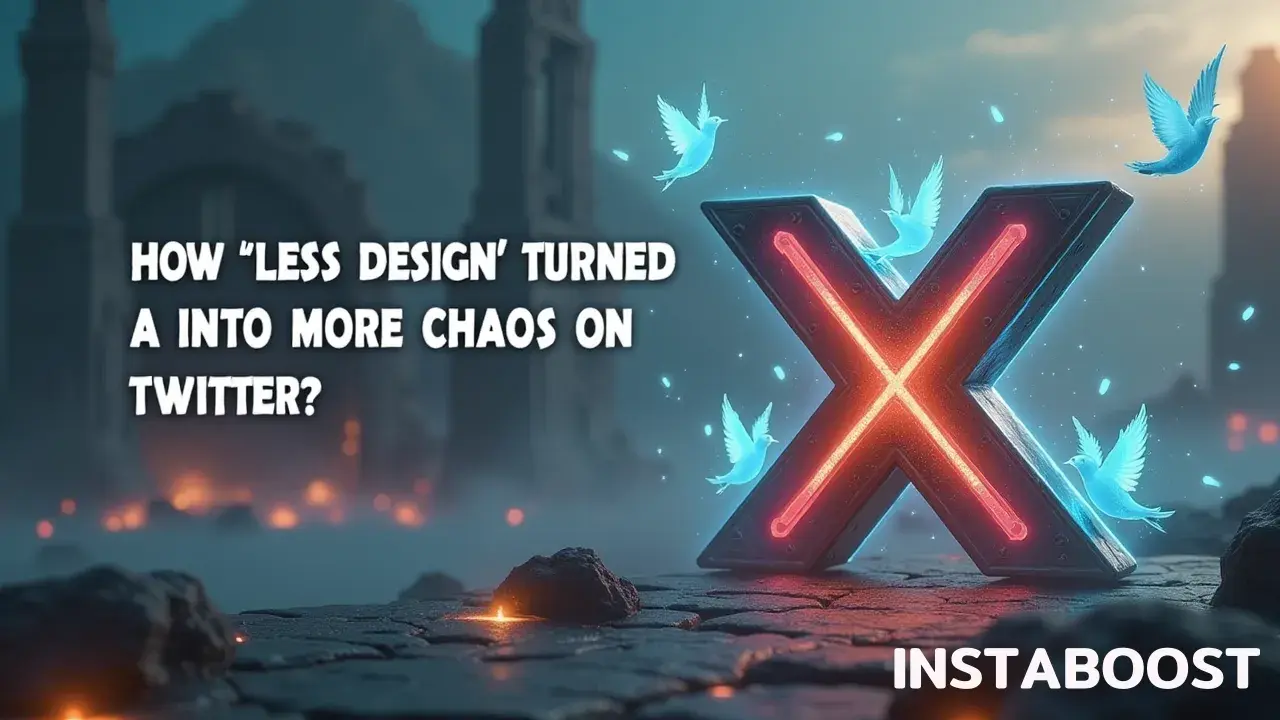Did “Less Design” Create More Chaos on X (Twitter)?
Streamlined design can create confusion when clarity is reduced. Timing a single visual change and tracking replies in the first hour reveals whether context is being lost and where friction appears. Small, incremental tests preserve attention while allowing room for growth and adjustment. A measured rollout keeps focus on clarity first, then refinement.
When “Less Design” Became Less Guidance
Twitter’s move toward “less design” sounded like a push for clarity – fewer buttons, cleaner lines, more focus. But the quiet work of interfaces isn’t decoration; it’s signaling. Labels tell you what something does, shape suggests what kind of thing it is, color sets priority, and spacing helps people see their options. When those cues disappear, the complexity doesn’t go away – it shifts into the user’s memory. That’s why the minimal turn made things feel confusing: people had to think harder about state and risk. Was a retweet private or public?
Is a bookmark safe or visible to others? Does the view count reflect reach, interest, or only impressions? The screen looked tidier while the choices got harder to read. Minimalism only works when context repeats itself or doesn’t matter. A calculator can have fewer keys and still cover the basics.
In social software, context is the whole point. Interface elements need to carry social signals – who sees what, what sticks around, what you can undo, what has consequences. When you strip visual differences, compress actions into the same control, or hide labels, you force essential decisions onto pattern recognition and recall. People make do; the platform pays in misclicks, misreads, and mistrust. The “view count” is a good example: it looked like a clean metric, but it pulled attention without explaining intent.
Is it a vanity number or a useful KPI? Without cues about audience, timeframe, or the quality of attention, “views” mislead more than they help. This essay looks at how “less design” on Twitter removed the scaffolding that made actions legible. We’ll look at what interfaces actually do – encode state, priority, and risk – and how cutting so‑called “visual noise” can erase meaning. The point isn’t to praise ornament; it’s to keep the simple agreement UI makes with our minds: show me what matters before I act and Twitter profile optimization doesn’t become a crutch for ambiguity we could have resolved in the interface.

What We Measured vs. What Mattered
The metric that mattered wasn’t even on the dashboard. In Twitter’s “less design” stretch, the team focused on what was simple to see and count – views, likes, time on feed – while the signals that guide behavior stayed off the books: clear labels, solid affordances, and how well people recover from mistakes. When you remove labels and cues, you also remove your confidence in what engagement means. A spike in views might be confusion: extra taps because a button looks like a link, more impressions because a thread state isn’t obvious, longer sessions because people are lost, not engaged.
That’s how “less design” became more mess: the system optimized what it could see and quietly eroded what it didn’t measure, a pattern you can spot in the way people chase Twitter followers cheap while overlooking whether anyone understands what the interface is asking them to do. A credible product practice treats interface signals as leading indicators and tracks them: task completion without backtracks, first-try success on core actions, hesitation time before a click, the misclick-to-correction ratio, the rate of unintended posts. When those move, you learn whether the UI is teaching or tricking.
Views are a noisy KPI; they don’t separate comprehension from drift. If you want a real read on Twitter’s health, instrument comprehension: can a new user predict what tapping Reply will do the first time? Does the share sheet produce the intended result without retries? Are moderation cues easier to find than virality cues? Call it a comprehension quotient. Until that sits next to engagement, the platform will keep high-fiving friction it can’t see – and shipping changes that look minimal but cost users cognitive load. It’s not elegance so much as a blind spot with a number on it.
Design Guardrails as Operating System
Structure is how creativity survives burnout. When Twitter chased “less design,” they didn’t remove complexity; they pushed it onto people using the product and the folks moderating it. Strategy is about choosing where that complexity belongs. If the interface is the company’s operating system, then labels, spacing, and affordances are the APIs – guardrails you can enforce so behavior stays legible. Strip them away and you’re asking people to remember what unlabeled icons mean, guess at what matters on a screen, and fix mistakes without cues. That load looks clean in a mockup and messy at scale.
The fix isn’t more chrome; it’s clearer constraints. Set non‑negotiables: every meaningful action gets a verb label, every destructive path shows a patterned warning, and every feed item has a stable way to mute or report. Align metrics to those rules: pair views with a clarity rate (how many people correctly predict an action), error recovery time, and intent matching (did the tap do what they expected?), and remember how easy it is for “engagement” to drift into surface signals like organic-looking X likes that mask whether people actually understood what they were doing. Treat minimalism like a budget, not a rule: when you remove a cue, add a system‑level signal – progress states, empty‑state guidance, hover or press affordances.
Make governance visible: publish pattern health like uptime – label coverage, tap‑target consistency, accessibility contrast. That turns “less design” from an aesthetic into discipline. You get fewer buttons without fewer instructions, which is how you calm a feed like Twitter and make engagement metrics mean something again. Think of it as interface reliability engineering: reduce memory load, increase legibility, and let the feed optimize within guardrails instead of against them. That’s a kind of reliability both search engines and people can trust, and it’s closer to how we build systems that last than anything that starts with a blank canvas and a shrug.
Minimal Isn’t Neutral
It looked fine in a slide deck, until real people had to use it. The push for “less design” sounded tidy: drop labels, rely on icons, let the interface fade away. But that isn’t neutral; it assumes everyone reads visuals the same way and is okay guessing.
Minimalism is a bet about how people think. When Twitter stripped cues, it didn’t make things simpler – it hid the hard parts. It pushed interpretation onto users and moderators, then called it “engagement” when confusion turned into extra taps, mis-clicks, and retries. If the interface is the operating system, labels and affordances are the agreements. Break the agreement and the numbers start lying to you. A clean screen can boost “views” while hurting comprehension, recovery, and trust – the stuff that doesn’t show up on a dashboard.
That’s why the “view count” argument feels off: it gets treated like a KPI when it’s mostly a vanity metric covering a muddled experience, not unlike the noise around tools such as a tweet visibility booster that inflate impressions without improving understanding. Good UI makes state, priority, and risk obvious; it prevents mistakes and makes exits easy when they happen. Minimal UI without clear structure does the opposite. The costs slide downstream as moderation load, support tickets, and churn that attribution tools mislabel as something else.
Real simplicity is measured by how little a person has to remember, not how little a designer draws. So no, “less design” didn’t make Twitter elegant – it moved the UI’s unpaid work onto people. If you want less chaos, bring back the guardrails: explicit labels for destructive actions, spacing that shows hierarchy, and controls that make consequences visible before you click. That’s not decoration – it’s the grammar that keeps a social network readable, day to day, in the middle of everything else users are trying to do and think through.
Ship Fewer Mysteries, Not Fewer Pixels
You can scroll past this, or you can start something. The way out of Twitter’s “less design, more chaos” loop isn’t a big swing redesign; it’s a steady habit of shipping fewer mysteries. Treat interface choices like policy, because they are. If design guardrails are the operating system, product changes need code-level discipline: testable assumptions, clear contracts, and a rollback plan when legibility drops. Start with a principle: if a UI change adds even one extra guess, it has to pay that back with clarity somewhere else. That alone would have stopped the run of unlabeled icons and the “view count” fixation, where a vanity metric posed as a useful KPI and quietly pushed behavior around.
Views can be useful for reach diagnostics, but only with context – who saw it, how it spread, what happened after – not a vanity detour like fast retweet delivery masquerading as signal. Minimal isn’t neutral; it’s a bet about shared understanding. Make the bet explicit. If you remove a label, publish the success bar (“90% recognition in three seconds for new users”) and track what follows: retention, error rate, moderation workload. Track design debt like tech debt, with a burn-down tied to accessibility issues and misuse reports, not just NPS.
And when you simplify, simplify the decision, not the hint: consolidate actions, reduce states, keep the cues. That’s how you cut ornament without losing orientation. The payoff compounds: fewer misclicks, calmer moderation queues, analytics that reflect what’s actually happening instead of wishful counting. In other words, ship clarity. It costs less than chaos, and you feel it in day-to-day work, not a launch blog post and fast retweet delivery.
The Cost of “Less” Is Paid in User Memory
A clean-looking interface isn’t always easier to use; it often pushes the hard part onto the person using it. That’s where Twitter’s “less design, more chaos” shift shows its cost. When labels fade and icons carry the load, the UI stops explaining what’s happening – state, priority, risk – and starts testing your recall. Did that star save a tweet, subscribe to a user, or mark it as a favorite? The interface used to answer; now your memory does. Spread that across reporting, muting, where view counts sit, and you get friction that doesn’t show up in screenshots but slows you down in real use.
The odd thing is that minimalism can raise cognitive load while blurring accountability. When it’s hard to read, who takes the blame – the feature, or the person who “didn’t get it”? That’s why “ship fewer mysteries” beats shipping fewer pixels. Product teams need promises the interface keeps: a control signals its consequence; a metric makes its scope clear; a default shows its bias. I’ve seen teams chase metrics the way users chase badges and buy Twitter engagement only to realize later that the numbers lacked context and warped behavior. Look at view count as an example: as a vanity number, it nudges people toward performative posting; as a KPI, it only helps if it’s scoped – by audience, time window, and intent – and paired with signals like replies or follows that show actual engagement.
Without that context, you train people to chase noise. Minimal design isn’t neutral; it moves the work around. Good design takes responsibility for the work it creates by encoding context instead of stripping it away. If you want less chaos on Twitter or any social app, don’t delete affordances – shape them into clear patterns, run measured experiments, define transparent metrics, and roll back when legibility starts to slip. Not aesthetic minimalism, but operational clarity, and a little less guesswork for the person on the other side of the screen.















